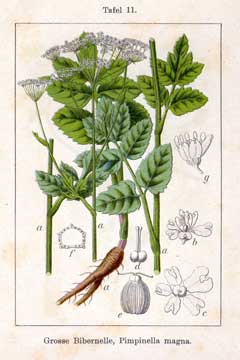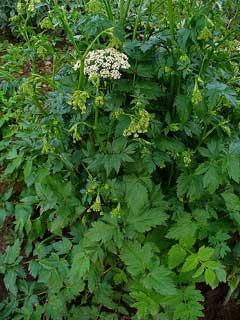 |
|
http://commons.wikimedia.org/wiki/File:Pimpinella_major_Sturm11.jpg |
 |
| http://commons.wikimedia.org/wiki/User:Llez |
Translate this page:
Summary
Physical Characteristics

 Pimpinella major is a PERENNIAL growing to 0.8 m (2ft 7in) by 0.3 m (1ft).
Pimpinella major is a PERENNIAL growing to 0.8 m (2ft 7in) by 0.3 m (1ft).
See above for USDA hardiness. It is hardy to UK zone 5 and is not frost tender. It is in flower from June to July, and the seeds ripen from July to August. The species is hermaphrodite (has both male and female organs) and is pollinated by Bees. The plant is self-fertile.
Suitable for: light (sandy), medium (loamy) and heavy (clay) soils. Suitable pH: mildly acid, neutral and basic (mildly alkaline) soils. It can grow in semi-shade (light woodland) or no shade. It prefers moist soil.
UK Hardiness Map
US Hardiness Map
Synonyms
Pimpinella saxifraga var. major L.
Plant Habitats
Woodland Garden Sunny Edge; Shady Edge; Hedgerow;
Edible Uses
Edible Parts:
Edible Uses: Condiment
An essential oil from the roots is used as a flavouring in candy, liqueurs etc[183].
References More on Edible Uses
Medicinal Uses
Plants For A Future can not take any responsibility for any adverse effects from the use of plants. Always seek advice from a professional before using a plant medicinally.
Antiinflammatory Astringent Carminative Diuretic Expectorant
The leaves are diaphoretic, diuretic, resolvent and stomachic[4]. The plant is harvested as it comes into flower and dried for later use[4]. The root is anti-inflammatory, mildly astringent and expectorant[9]. The fresh root is very hot and acrid, but this pungency is greatly reduced when the root is dried[4]. When chewed, the fresh root is effective in treating toothaches and paralysis of the tongue[4]. An effective diuretic, the root is used in treating disorders arising from obstructions of the viscera[4]. The root is also used for soothing coughs or the effects of laryngitis and bronchitis[9]. The roots can be harvested in the spring or autumn and are dried for later use[9]. The seeds are carminative[4]. The German Commission E Monographs, a therapeutic guide to herbal medicine, approve Pimpinella major Greater Burnet Saxifrage for cough/bronchitis (see [302] for critics of commission E).
References More on Medicinal Uses
The Bookshop: Edible Plant Books
Our Latest books on Perennial Plants For Food Forests and Permaculture Gardens in paperback or digital formats.

Edible Tropical Plants
Food Forest Plants for Hotter Conditions: 250+ Plants For Tropical Food Forests & Permaculture Gardens.
More

Edible Temperate Plants
Plants for Your Food Forest: 500 Plants for Temperate Food Forests & Permaculture Gardens.
More

More Books
PFAF have eight books available in paperback and digital formats. Browse the shop for more information.
Shop Now
Other Uses
References More on Other Uses
Cultivation details
Easily grown in any good soil[1], preferring rather moist conditions[187]. Grows best in a cool position[233]. Plants are hardy to about -20°c[187].
References Carbon Farming Information and Carbon Sequestration Information
Temperature Converter
Type a value in the Celsius field to convert the value to Fahrenheit:
Fahrenheit:
The PFAF Bookshop
Plants For A Future have a number of books available in paperback and digital form. Book titles include Edible Plants, Edible Perennials, Edible Trees,Edible Shrubs, Woodland Gardening, and Temperate Food Forest Plants. Our new book is Food Forest Plants For Hotter Conditions (Tropical and Sub-Tropical).
Shop Now
Plant Propagation
The seed requires a period of cold stratification. If you can obtain fresh seed then it is best sown immediately. This can be done in situ if you have sufficient seed, but if you only have a small quantity then it is safer to sow it in pots in a cold frame. Sow stored seed as soon as you can obtain it, this is probably best done in a cold frame. When they are large enough to handle, prick the pot-grown seedlings out into individual pots and plant them out in the summer.
Other Names
If available other names are mentioned here
Native Range
EUROPE: Denmark, United Kingdom, Ireland, Norway, Sweden, Austria, Belgium, Switzerland, Czech Republic, Germany, Hungary, Liechtenstein, Netherlands, Poland, Slovakia, Russian Federation (European part), Belarus, Estonia, Lithuania, Latvia, Moldova, Ukraine, Bulgaria, Bosnia and Herzegovina, Croatia, Italy, Montenegro, Romania, Serbia, Slovenia, Spain, France
Weed Potential
Right plant wrong place. We are currently updating this section.
Please note that a plant may be invasive in one area but may not in your area so it's worth checking.
Conservation Status
IUCN Red List of Threatened Plants Status :

Growth: S = slow M = medium F = fast. Soil: L = light (sandy) M = medium H = heavy (clay). pH: A = acid N = neutral B = basic (alkaline). Shade: F = full shade S = semi-shade N = no shade. Moisture: D = dry M = Moist We = wet Wa = water.
Now available:
Food Forest Plants for Mediterranean Conditions
350+ Perennial Plants For Mediterranean and Drier Food Forests and Permaculture Gardens.
[Paperback and eBook]
This is the third in Plants For A Future's series of plant guides for food forests tailored to
specific climate zones. Following volumes on temperate and tropical ecosystems, this book focuses
on species suited to Mediterranean conditions—regions with hot, dry summers and cool, wet winters,
often facing the added challenge of climate change.
Read More
Expert comment
Author
(L.)Huds.
Botanical References
17200
Links / References
For a list of references used on this page please go here
Readers comment
| Add a comment |
|
If you have important information about this plant that may help other users please add a comment or link below. Only comments or links that are felt to be directly relevant to a plant will be included. If you think a comment/link or information contained on this page is inaccurate or misleading we would welcome your feedback at [email protected]. If you have questions about a plant please use the Forum on this website as we do not have the resources to answer questions ourselves.
* Please note: the comments by website users are not necessarily those held by PFAF and may give misleading or inaccurate information.
To leave a comment please Register or login here All comments need to be approved so will not appear immediately.
|
Subject : Pimpinella major
|
|
|
|